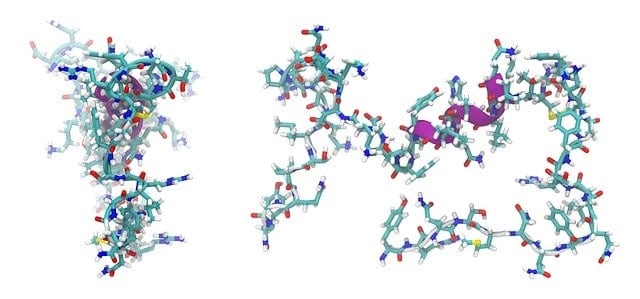Most proteins become functional once they acquire their native three-dimensional structure, which is dictated by the primary amino acid sequence of the protein. Denaturation is when proteins, or more specifically, nucleic acids, lose their three-dimensional structure. The occurrence of denaturation can be due to many external factors; subsequently, this event can irreversibly disrupt the protein’s functionality1.
Forces Involved in Protein Stability
In the cell, linear polypeptides are synthesized from a sequence of mRNA through a process known as translation. As the polypeptide is synthesized, it begins to fold into its three-dimensional structure in a process known as protein folding.
The secondary structure, which includes the alpha helices and beta sheets, is stabilized by intramolecular hydrogen bonds between the amide hydrogen and carbonyl oxygen of the peptide bond that links the amino acids of the primary structure.

Interactions between side chains of amino acids that comprise the protein determine the tertiary structure. The structure is firmly maintained due to the strength of hydrophobic interactions and the disulfide that bridges the cysteine residues of the amino acids.
Lastly, the quaternary structure of a protein is determined by the interaction of the subunits of peptide chains that compose the molecule and the hydrogen bonds and hydrophobic reactions that occur between them2.
Protein stability after folding is crucial for the polypeptide to perform correctly. Therefore, the cell uses diverse mechanisms to guarantee this functionality. Chaperones are a class of peptides that aid in the correct folding of other proteins by interacting with the polypeptide chain that is being synthesized, reducing possible unwanted mutations of the polypeptide3. Despite chaperone actions, some proteins still misfold; due primarily to cell mutations. For example, the protein is susceptible to misfolding when there are changes in non-covalent interactions. Studies show that misfolding or failure to fold into native structures leads to
The Phenomenon of Protein Denaturation
External factors such as changes in pH levels, radiation, heat, and other environmental stressors can produce mutations and cause protein denaturation. This event can affect normal cell activity and, as a result, cause the loss of protein function. Incorrect protein folding can lead to an undesirable incident known as protein aggregation, which consists of accumulating misfolded proteins inside or outside the cell. Protein aggregation can cause neurological disorders such as Alzheimer’s, Parkinson’s, and other diseases, including amyloidosis and prion disease4.
By measuring protein unfolding and stability, scientists can predict the onset of these diseases, among others. In addition, understanding protein
In conclusion, understanding protein stability is crucial for identifying which exact disorder is affecting a patient and is also necessary for the design and production of stable drugs to treat diseases and/or for correcting specific regulatory folding networks.
SOURCES:
- https://askabiologist.asu.edu/activities/breaking-proteins
- https://www.britannica.com/science/protein/Protein-denaturation
- https://www.ncbi.nlm.nih.gov/pmc/articles/PMC4131146/
- https://www.ncbi.nlm.nih.gov/pmc/articles/PMC6506414/
- https://www.sciencedirect.com/topics/pharmacology-toxicology-and-pharmaceutical-science/drug-stability

